Man Overboard Incidents - How to help your
casualty back on board
This is the final article in our three-part series, looking at
how to prepare for and deal with man overboard situations.
In previous articles, we highlighted some useful techniques for
identifying a casualty in the water and discussed how we could
make contact. Here we consider how to get your casualty back on
board.
Sadly many MOB situations have ended in tragedy with the
casualty brought successfully alongside the boat but the crew
are unable to recover them from the water.
Consider them helpless
Even in the summer months, the water temperatures around the
coasts of the UK can be cold. We often forget that a pleasant
paddle at the beach is a totally different situation to falling
off a vessel a mile or so off shore.
Falling from a yacht can be a real fright and even the fittest
crew member will not be able to avoid the almost instantaneous
'cold shock' that is experienced as we hit the water.
If the casualty is not wearing a life jacket then he or she will
rapidly tire as they struggle to tread water whilst
involuntarily keeping their head as high as they can as they
search for rescue.
It does not take take long for a casualty to become utterly
exhausted and as a result they will often become helpless.
This must be at the forefront of our planning and thinking when
we consider how we are going to get a man overboard safely back
on board.
1. Fixed Boarding Ladders
 Many
boats, both power and sail, have a boarding ladder fixed to the
transom. Whilst the majority of installations have been designed
for the benefit of leisurely swimmers, we must not forget their
usefulness in more serious circumstances. Many
boats, both power and sail, have a boarding ladder fixed to the
transom. Whilst the majority of installations have been designed
for the benefit of leisurely swimmers, we must not forget their
usefulness in more serious circumstances.
It is worthwhile considering how effective your boarding ladder
might be in more challenging sea conditions rather than when you
are at anchor.
An effective boarding ladder should extend at least a metre
below the surface, allowing a swimmer to get one foot on the
bottom rung even if the boat is moving around in a swell.
Sailing Vessels
On sailing boats this might be more difficult as a yacht transom
can often be higher than those on motor vessels, so you may want
to consider changing your ladder to one that offers a greater
length when deployed.
Motor Vessels
Many motor vessels have bathing platforms that extend from the
transom and often you can find telescopic boarding ladders
mounted into the trailing edge or bolted to the lower surface.
Being so close to the water, these can often be a very
attractive means of recovery, but
DON'T FORGET, just a few feet below these swim
platforms is a whirling propeller (or two) and a weary swimmer
can easliy blunder too close in their panic to get out of the
water.
If you are the skipper of a power-driven vessel and there is a
person in the water alongside then STOP THE ENGINES
IMMEDIATELY!
With the engines shut down you can then lead the swimmer safely
to the transom for recovery.
Top Tips
- Before a crew member leaves
the safety of the cockpit to step onto a swim platform to help
a person back on board, make sure they are WEARING A
LIFEJACKET, with a deck safety harness and life
line in place if possible
- Swim platforms can be
relatively exposed with few hand holds, so it is a good idea
to consider installing several safety line attachment points
where crew member can tether themselves whilst helping to
recover a person from the water.
2. Mobile Boarding Ladders
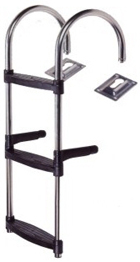 On
many vessels, it is simply not practical to mount a permanent
boarding ladder on the transom, so many people use portable
boarding ladders that can be stored in a locker. On
many vessels, it is simply not practical to mount a permanent
boarding ladder on the transom, so many people use portable
boarding ladders that can be stored in a locker.
Available in various lengths and configurations, these can
either be hooked over the toe rail or clipped onto the deck
using a pair of flush-fitting keyhole plates.
If you are considering this type of ladder then it is a good
idea to position it 'mid-ships' because if the boat is moving up
and down in a swell, then the centre of the vessel will move the
least. The bow and stern often rise and fall much more
prominently.
3. Webbing Ladders
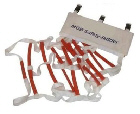 Webbing
boarding ladders are very popular because they are extremely
compact but they can extend considerably longer than a fixed
boarding ladder. They are deployed by clipping the bag to a toe
rail or transom then ripping open the cover allowing the ladder
to fall. Webbing
boarding ladders are very popular because they are extremely
compact but they can extend considerably longer than a fixed
boarding ladder. They are deployed by clipping the bag to a toe
rail or transom then ripping open the cover allowing the ladder
to fall.
Shorted handed or single handed crews often have one permanently
clipped to the transom with the deployment handle in easy reach
for a swimmer to grab.
4. Rescue Slings
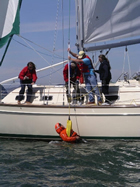 Because
it is highly likely that the casualty will be exhausted when
they are brought alongside, they simply may not be able to haul
themselves onto a ladder. Because
it is highly likely that the casualty will be exhausted when
they are brought alongside, they simply may not be able to haul
themselves onto a ladder.
With clothing trapping a lot of water, the assisting crew may
find it extremely difficult and heavy to pull the casualty up
and onto the vessel. This is when mechanical assistance may be
required.
One of the devices you could choose to use in this situation, is
a rescue sling. This is a padded sling which is attached to
20-30m of floating line. Instead of throwing this device
overboard the vessel, it is simply streamed out behind and then
the vessel circles the casualty a couple of times.
As the lines pass the crew in the water, they can grab hold and
put the sling under their arms, allowing the crew on board to
haul them in. This avoids the weakened casualty having to
'hang-on'.
Once the casualty is alongside, a halyard can be attached to the
two metal D-rings in the centre of the sling and the crew member
can then be winched on board in a similar manner to being
winched up by a helicopter.
5. Rescue Scoops
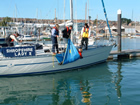 An
alternative to a sling, is to recover a crew member using a
rescue scoop. An
alternative to a sling, is to recover a crew member using a
rescue scoop.
This device is essentially a triangular or square-shaped panel
which is attached to the vessel's toe rail or stanchions.
The panel is then deployed over the side so that it is submerged
making a u-shape in the water. The outer tip of the panel is
attached to halyard and when the casualty is floated into the
scoop, the halyard is winched up and the scoop rolls the
casualty up the side of the vessel.
Once at deck level the crew can then manoeuvre the casualty over
the toe rail.
An additional benefit of this
method of recovery is that it prevents gravity draining blood
away from the casualty's core organs because the body is kept in
a nearly horizontal position.
6. Practice
As with any safety equipment, it is no good just buying a new
device and storing it in a locker until you need it!
You must read the instructions thoroughly and make sure you
understand how it is supposed to work. Where practical, and
ONLY IF IT IS SAFE, you should practice deploying the
equipment to see how it is best used on your own vessel.
We would never advocate placing crew in the water for the
sake of practice, unless the crew member was in good physical
health and there was the additional support of a separate rescue
boat.
|


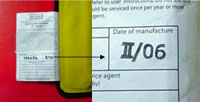 Seago Yachting has released a statement saying that some Seago
150 and 175 Newton Lifejackets, including Junior Lifejackets,
may have a defect which could result in serious injury.
Seago Yachting has released a statement saying that some Seago
150 and 175 Newton Lifejackets, including Junior Lifejackets,
may have a defect which could result in serious injury. 

 Many
boats, both power and sail, have a boarding ladder fixed to the
transom. Whilst the majority of installations have been designed
for the benefit of leisurely swimmers, we must not forget their
usefulness in more serious circumstances.
Many
boats, both power and sail, have a boarding ladder fixed to the
transom. Whilst the majority of installations have been designed
for the benefit of leisurely swimmers, we must not forget their
usefulness in more serious circumstances. On
many vessels, it is simply not practical to mount a permanent
boarding ladder on the transom, so many people use portable
boarding ladders that can be stored in a locker.
On
many vessels, it is simply not practical to mount a permanent
boarding ladder on the transom, so many people use portable
boarding ladders that can be stored in a locker. Webbing
boarding ladders are very popular because they are extremely
compact but they can extend considerably longer than a fixed
boarding ladder. They are deployed by clipping the bag to a toe
rail or transom then ripping open the cover allowing the ladder
to fall.
Webbing
boarding ladders are very popular because they are extremely
compact but they can extend considerably longer than a fixed
boarding ladder. They are deployed by clipping the bag to a toe
rail or transom then ripping open the cover allowing the ladder
to fall. Because
it is highly likely that the casualty will be exhausted when
they are brought alongside, they simply may not be able to haul
themselves onto a ladder.
Because
it is highly likely that the casualty will be exhausted when
they are brought alongside, they simply may not be able to haul
themselves onto a ladder. An
alternative to a sling, is to recover a crew member using a
rescue scoop.
An
alternative to a sling, is to recover a crew member using a
rescue scoop.



